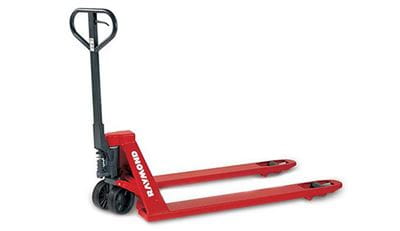Pallet Jacks | Orange County

Raymond West is an Orange County supplier of new and used electric and manual pallet jacks.
We are backed by one of the largest service and parts operations in Southern California.
Call us today at (714) 790-9300
If you're considering the acquisition of pallet trucks, it's crucial to weigh the advantages and a few of the disadvantages of different styles of pallet equipment.
Naturally, the fundamental function of a pallet jack is to move pallets around a storage facility, industrial operation or some other enterprise where pallets must be transferred.
That being said, based on the size of your facility, the gross weight of pallets that need to be positioned, the frequency of use and other factors, you may wish to get a more thorough awareness of which pallet jacks perform best in which environments.
The following feature is a review of pallet jack classifications, features, limits and use cases.
Manual Pallet Trucks
Non-motorized pallet trucks have been in existence since the early 1900's and have not been modified much since then. They consist of a steel chassis, a fork and a hydraulic unit that's activated by pushing the handle vertically.
The operator of a non-powered pallet jack sets the forks beneath the pallet, raises the pallet off the ground and pushes the pallet to a secondary point, directing the equipment with the handle.
Any place where lift elevation is not required may be a suitable use for a manual pallet truck, including grocery store aisles, warehouse loading docks and similar. As opposed to a lift truck, manual pallet jacks are also relatively transportable and will fit in the back of a truck or cargo van for delivering goods. The load limit of many manual pallet jacks is about 5500 pounds.
Non-powered pallet jacks are best for infrequent use situations across short ranges. Manual units are not the best selection for transporting payloads across extended lengths, slopes or rough surfaces. Operators need to physically maneuver the pallet jack which may be physically draining after a period of time.
Walkie Pallet Trucks
Although about two times the scale of manual pallet trucks, walkies are nonetheless fairly small in scale and they're exceptionally maneuverable.
Walkie pallet jacks are electrified by on-board battery units. The battery provides a powered assist for propelling and elevating the forks. The worker no longer has to use the handle to lift the load, nor do they have to manually propel the load along through the warehouse.
Nevertheless, they're still known as "walkies”, given that the driver does still have to walk in back of or next to them.
A walkie pallet jack's max speed is lower in comparison with rider jacks, given that the driver must keep up with it instead of standing on it. This is in fact somewhat of a built in "safety feature", since limited speeds also minimize the impact of collisions.
The maximum capacity of the majority of walkie pallet jacks is between 4500-6000 lbs.
Though they're more practical than non-motorized pallet jacks, walkies have to be charged on a regular basis, because they are battery based. In addition, they demand more care than hand pallet trucks because there are more moving pieces and points of potential electrical issues.
The key applications for walkie pallet trucks are trailers, dock plates and short to mid-distance runs.
Rider Pallet Trucks
Rider pallet jacks are similar to walkies, except that they feature a standing platform for the user. There are few controls on rider jacks so they are relatively straightforward to operate and necessitate very little operator training.
Controllers can climb on the platform rather than just walking behind or beside the pallet truck. This means that rider trucks are a more efficient choice for moving pallets across greater ranges vs walkie or hand pallet trucks. Rider jacks are perfect for constant movement over longer ranges and they are used frequently in large warehouses and industrial enterprises.
The driver platform is satisfactory for quick trips, but not great for users that make use of them all day long because they're fairly compact and cause the user to stand in an unnatural stance.
Rider jacks are larger than hand or walkie pallet jacks, so collisions can result in relatively significant injury and property harm. Rider jacks offer little protection for the operator vs other equipment such as center riders.
Center Riders
Center riders are similar to rider pallet trucks, but they are more protected for the controller and allow a more ergonomic ride. The driver can stand totally forward or backward instead of solely to the side.
Additionally, there is lower hazard for the user considering they're shielded by the machine body on two sides, although they're still exposed to the potential risk of the lifting mechanism.
Center riders are less maneuverable than rider pallet trucks and they're best suited for uses where the user proceeds mainly in a direct path.
Center riders are commonly employed in general manufacturing, warehouse and beverage applications.
Where To Rent Or Buy Pallet Trucks In Ontario
If you’d like to contact a representative about pallet jacks, please get in touch with Raymond West, an Orange County material handling equipment supplier serving all of Orange County, including: Anaheim, Costa Mesa, Fullerton, Garden Grove, Orange, Santa Ana, and Tustin.
Orange County, CA
1800 N Bristol St
Santa Ana, CA 92706
(714) 790-9300
7:00 AM - 5:00 PM
Monday - Friday

